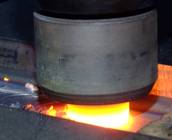SLV – Schweißtechnische Lehr- und Versuchsanstalten



Testing of new tool materials for the friction stir welding of steel

As a rule, the friction stir welding of aluminium no longer constitutes a problem. The customers of SLV Berlin-Brandenburg, NL der GSI mbH receive corresponding advice and support. However, if it is a question of the friction stir welding of steels, the situation is already absolutely different. Problems continue to exist here; primarily with regard to the tool. While a creep-resistant working steel is sufficient for the welding of aluminium, it looks totally different in the case of the steels. Even at high welding temperatures (approx. 1,100°C), these tools must not lose their strength and should be relatively wear-resistant in addition. Tools made of tungsten/rhenium and PCBN are customary at present; but solid hard metals are also suitable to a certain extent. In any case, one common feature of almost all these materials is that they are not stable enough to make friction stir welding attractive for users in the steel sector. PCBN (polycrystalline cubic boron nitride) forms one exception here. This exhibits corresponding durability but is very expensive and difficult to purchase.
In order to remedy this circumstance, SLV Berlin-Brandenburg got together with several partners and developed a tool material which satisfied the requirements but is cheaper than PCBN and can be purchased in Germany.
In order to make it easier to enter this development, parameters were established on normal-strength shipbuilding steel, Grade A (here, there is no special demand from the maritime sector) with a minimum yield strength of 235 N/mm², a tensile strength of 400 520 N/mm² and a material thickness of 4 mm with tools made of tungsten/rhenium. The new tool alloy was utilised thereafter. These tools have a metallic basis consisting of tantalum. The first tests already showed that the tools exhibited considerably better behaviour than tungsten/rhenium tools. This tantalum-based alloy did not show any affinity for steel either. This was reflected in a very good weld surface. The expectations on this material were exceeded at first. The following technical parameters were initially established after a few tests, also with other alloy compositions of the tool:
Penetration speed of the tool: 10 mm/min
Dwell time (plastification time): 0.5 s
Welding speed: 12 mm/min
Force in the Z direction: 20 kN
Revolutions of the tool: 700 rpm
Other important influences:
- The immersion region was preheated at the start (goes easy on the tool)
- The immersion took place at 1,900 rpm (also goes easy on the tool)
- The welding was carried out on a backing strip with rolling scale (prevents the adhesion of the component)
However, it was shown after four metres of the weld that the pin had lost length. Remedies for this were investigated at the University of Duisburg-Essen. Additional alloying elements made the material more resistant. At the same time, PCBN coatings in the micron (µ) range were applied by Materion. Thereafter, SLV Berlin-Brandenburg performed further welding tests. In this respect, it was possible to increase the welding speed to 500 mm/min while maintaining the weld quality. Our weld lengths at the end of the project reached ten metres and more. Thus, the first objective was attained.
At present, further investigations relating to materials engineering (fracture mechanics) are still being conducted at HZG in Geesthacht. With our partners, we want to successfully complete the development of a friction stir tool "Made in Germany" for steel welding. The first application in shipbuilding has already been planned: utilisation of the tool within the framework of a six-metre friction stir welding installation from IMG and Loitz-Robotik. This machine already exists. Here, it was possible to guide the research and economic fields to a small success at the same time.
This was a cooperation project and was promoted by ZIM (Central Innovation Programme for Medium-Sized Enterprises - Cooperation Measures) with Promotion Code VP2349001PK9.
